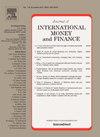CEOS’ climate risk perception bias and corporate debt structure
IF 3.3
2区 经济学
Q2 BUSINESS, FINANCE
引用次数: 0
Abstract
Climate risk, the biggest challenge faced by the human society, poses great complexities and difficulties to the corporate operations. Unlike previous studies focus on either the objective level of climate risks or the subjective perception for such risk, we quantify the difference between the objective level and subjective perception of climate risk and define as CEOs’ climate risk perception bias, and further explore the impact of the bias on the corporate debt structure. The empirical results reveal several key findings. First, the baseline regression results indicate that an increase in CEOs’ climate risk perception bias is positively associated with debt concentration, while simultaneously leading to a reduction in the number of debt instruments. Robustness checks confirm the stability of these findings across various model specifications and sample sets, enhancing the reliability of the observed relationships. Additionally, heterogeneity tests show that the significant effects of climate risk perception bias on debt structure are primarily present in firms with a proper understanding of climate risks, while those that underestimate or overstate such risks display non-significant changes. Mechanistically, our analysis highlights that CEOs’ climate risk perception bias significantly reduce R&D expenditures, reflecting a trade-off between immediate financial stability and long-term innovation potential. Furthermore, heightened perception biases correlate with decreased risk tolerance and increased financial constraints, limiting firms’ flexibility in adapting to changing market conditions. These findings emphasize the need for accurate climate risk assessments to inform corporate financial strategies. Policymakers should facilitate access to diverse financing options to help companies manage climate-related uncertainties while maintaining financial flexibility.
ceo气候风险感知偏差与企业债务结构
气候风险是人类社会面临的最大挑战,给企业经营带来了极大的复杂性和艰巨性。与以往的研究只关注气候风险的客观水平或对气候风险的主观感知不同,我们将气候风险的客观水平与主观感知之间的差异量化,并将其定义为ceo的气候风险感知偏差,并进一步探讨这种偏差对公司债务结构的影响。实证结果揭示了几个关键发现。首先,基线回归结果表明,ceo气候风险感知偏差的增加与债务集中度呈正相关,同时导致债务工具数量的减少。鲁棒性检查确认了这些发现在各种模型规格和样本集之间的稳定性,增强了观察到的关系的可靠性。此外,异质性检验表明,气候风险感知偏差对债务结构的显著影响主要出现在对气候风险有正确理解的企业中,而低估或夸大气候风险的企业则表现出不显著的变化。从机制上看,我们的分析强调,ceo的气候风险感知偏差显著降低了研发支出,反映了当前财务稳定与长期创新潜力之间的权衡。此外,感知偏差加剧与风险承受能力下降和财务约束增加相关,限制了企业适应不断变化的市场条件的灵活性。这些发现强调需要进行准确的气候风险评估,以便为企业财务战略提供信息。政策制定者应促进获得多样化的融资选择,以帮助企业管理与气候相关的不确定性,同时保持财务灵活性。
本文章由计算机程序翻译,如有差异,请以英文原文为准。
求助全文
约1分钟内获得全文
求助全文
来源期刊

Journal of International Money and Finance
BUSINESS, FINANCE-
CiteScore
4.20
自引率
4.00%
发文量
141
期刊介绍:
Since its launch in 1982, Journal of International Money and Finance has built up a solid reputation as a high quality scholarly journal devoted to theoretical and empirical research in the fields of international monetary economics, international finance, and the rapidly developing overlap area between the two. Researchers in these areas, and financial market professionals too, pay attention to the articles that the journal publishes. Authors published in the journal are in the forefront of scholarly research on exchange rate behaviour, foreign exchange options, international capital markets, international monetary and fiscal policy, international transmission and related questions.
 求助内容:
求助内容: 应助结果提醒方式:
应助结果提醒方式:


